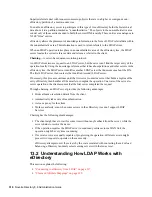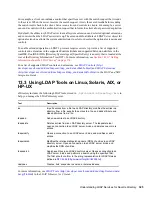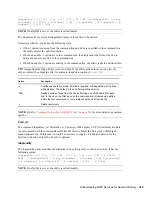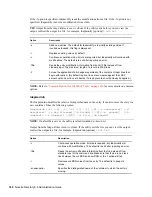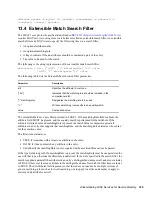
Understanding LDAP Services for Novell eDirectory
329
no
vd
ocx
(e
n)
6 Ap
ril 20
07
ldapdelete [-n] [-v] [-c] [-r] [-l] [-C] [-M] [-d debuglevel] [-e key
filename] [-f file] [-D binddn] [[-W]| [-w passwd]] [-h ldaphost] [-p
ldapport] [-Z[Z]] [dn]...
NOTE:
On a NetWare server, the utility is called ldelete.
The dn parameter is a list of distinguished names of the entries to be deleted.
It interacts with the -f option in the following ways:
If the -f option is missing from the command line and dn's are specified on the command line,
the utility deletes the specified entries.
If both dn and the -f option are in the command line, the utility reads the file for the dn's to
delete and ignores any dn's in the command line.
If both dn and the -f option are missing in the command line, the utility reads the dn from stdin.
TIP:
Output from the ldap utilities is sent to stdout. If the utility exits before you can view the
output, redirect the output to a file, for example, ldapdelete [options] >
out.txt
.
NOTE:
Refer to
“Common Options for All LDAP Tools” on page 326
for more details on common
options.
Example
The command ldapdelete "cn=Delete Me, o=University of Michigan, c=US" will attempt to delete
the entry named with the commonName Delete Me directly below the University of Michigan
organizational entry. In this case, it would be necessary to supply a binddn and passwd for the
deletion to be allowed (see the -D and -w options).
ldapmodify
The ldapmodify utility modifies the attributes of an existing entry or adds new entries. It has the
following syntax:
ldapmodify [-a] [-c] [-C] [-M] [-P] [-r] [-n] [-v] [-F] [-l limit] [-
M[M]] [-d debuglevel] [-e key filename] [-D binddn] [[-W]|[-w passwd]]
[-h ldaphost] [-p ldap-port] [-P version] [-Z[Z]] [-f file]
NOTE:
On a NetWare server, the utility is called lmodify.
Option
Description
-c
Continuous operation mode. Errors are reported, but ldapdelete will continue
with deletions. The default is to exit after reporting an error.
-f
file
Reads a series of lines from the file, performing one LDAP search for each
line. In this case, the filter given on the command line is treated as a pattern,
where the first occurrence of %s is replaced with a line from the file.
-r
Delete recursively.
Summary of Contents for EDIRECTORY 8.8 SP2
Page 4: ...novdocx en 6 April 2007...
Page 116: ...116 Novell eDirectory 8 8 Administration Guide novdocx en 6 April 2007...
Page 128: ...128 Novell eDirectory 8 8 Administration Guide novdocx en 6 April 2007...
Page 255: ...256 Novell eDirectory 8 8 Administration Guide novdocx en 6 April 2007...
Page 406: ...408 Novell eDirectory 8 8 Administration Guide novdocx en 6 April 2007...
Page 563: ...566 Novell eDirectory 8 8 Administration Guide novdocx en 6 April 2007...
Page 573: ...576 Novell eDirectory 8 8 Administration Guide novdocx en 6 April 2007...
Page 601: ...604 Novell eDirectory 8 8 Administration Guide novdocx en 6 April 2007...


